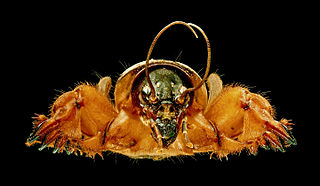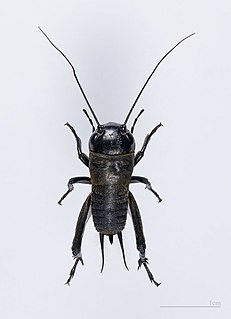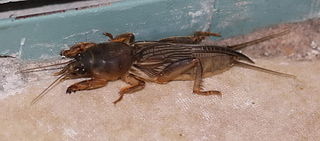
Orthoptera is an order of insects that comprises the grasshoppers, locusts, and crickets, including closely related insects, such as the bush crickets or katydids and wētā. The order is subdivided into two suborders: Caelifera – grasshoppers, locusts, and close relatives; and Ensifera – crickets and close relatives.

Mole crickets are members of the insect family Gryllotalpidae, in the order Orthoptera. Mole crickets are cylindrical-bodied, fossorial insects about 3–5 cm (1.2–2.0 in) long as adults, with small eyes and shovel-like fore limbs highly developed for burrowing. They are present in many parts of the world and where they have arrived in new regions, may become agricultural pests.
Gryllotalpa major,also known as the Prairie Mole Cricket, is endemic to the United States and is the largest cricket in North America. Its natural habitat is temperate grassland and it belongs to the family Gryllotalpidae. It is threatened by habitat loss, and is currently only found in Oklahoma, Kansas, Missouri, Nebraska and Arkansas. Males of this species produce sounds by rubbing their fore wings together. They sing from special burrows they construct in the prairie soil to attract females for mating, and they can be heard at distances up to 400 m from the burrow. Males aggregate their acoustic burrows in a lek arena and are very sensitive to vibrations carried through the ground. Males communicate with neighboring males through vibrational signals, and the songs they project to flying females are harmonic chirps, rather than the trills produced by most mole crickets.

Gryllotalpa gryllotalpa, commonly known as the European mole cricket, is widespread in Europe and has been introduced to the eastern United States. The scientific name is derived from the Latin 'gryllus' meaning a cricket and 'talpa', a mole, and is descriptive because of the fine dense fur by which it is covered and its subterranean habits, and because of the mole-like forelegs adapted for digging, a good example of convergent evolution.

Larra bicolor is a parasitoid wasp native to South America. It was introduced into Florida as a biological pest control of invasive mole crickets.

Crickets are orthopteran insects which are related to bush crickets, and, more distantly, to grasshoppers. In older literature, such as Imms, "crickets" were placed at the family level, but contemporary authorities including Otte now place them in the superfamily Grylloidea. The word has been used in combination to describe more distantly related taxa in the suborder Ensifera, such as king crickets and mole crickets.
Sam W. Heads is a British palaeontologist, a Fellow of the Linnean Society of London, a Fellow of the Royal Entomological Society, as well as a former Officer and Editor-in-Chief at the Orthopterists' Society.

Gryllotalpa orientalis is a species of mole cricket in the family Gryllotalpidae, commonly known as the oriental mole cricket. It is found in much of Asia and Australasia. At one time, this species was misidentified as G. africana and thought to have a widespread distribution in both Africa and Asia, but in the 1980s, G. orientalis was recognised as a separate species. It is a polyphagous pest, damaging crops by gnawing their roots.
Pheropsophus aequinoctialis is a species of ground beetle from Central and South America that feeds as larvae on the eggs of mole crickets but as an adult is a generalist feeder.

Gryllus rubens, commonly known as the southeastern field cricket, is one of many cricket species known as a field cricket. It occurs throughout most of the Southeastern United States. Its northern range spans from southern Delaware to the extreme southeastern corner of Kansas, with a southern range stretching from Florida to eastern Texas.
![Tridactylidae Family of [[Caelifera]]](https://upload.wikimedia.org/wikipedia/commons/thumb/2/24/Tridactylidae_IMG_1563m.JPG/320px-Tridactylidae_IMG_1563m.JPG)
The Tridactylidae are a family in the insect order Orthoptera. They are small, mole-cricket-like insects, almost always less than 20 mm (0.79 in) long when mature. Generally they are shiny, dark or black, sometimes variegated or sandy-coloured. They commonly live in short tunnels and are commonly known as pygmy mole crickets, though they are not closely related to the true "mole crickets" (Ensifera), as they are included in the Caelifera suborder.

Scapteriscus is a genus of insects in the family Gryllotalpidae, the mole crickets. Members of the genus are called two-clawed mole crickets. They are native to South America. Some species have arrived in other regions, including parts of North America, where some have become invasive and have become established as pests.
Steinernema scapterisci, the mole cricket nematode, is a species of nematode in the order Rhabditida. It is a parasite of insects in the order Orthoptera, the grasshoppers, crickets and their allies. Native to southern South America, it was introduced into Florida in the United States in an effort to provide a biological control of pest (Neoscapteriscus) mole crickets.
Ormia depleta, sometimes called the Brazilian red-eyed fly, is a species of fly in the family Tachinidae. It is a parasitoid of mole crickets in the genus Scapteriscus. It is native to South America but has been imported into the United States and elsewhere as a biological pest control agent.

Neoscapteriscus vicinus, the tawny mole cricket, is a species of insect in the mole cricket family, Gryllotalpidae. This species is native to South America and also occurs in the Southern United States, where it arrived as a contaminant of ship's ballast around 1900. Colombian insect taxonomist Oscar Cadena-Castañeda studied specimens of the genus which had been called Scapteriscus, and decided that it included two groups; a smaller group and a larger group that he named Neoscapteriscus in 2015. North American mole cricket taxonomists agreed with his decision and altered Orthoptera Species File Online accordingly.
Scapteriscus abbreviatus, the short-winged mole cricket, is a species of insect in the mole cricket family, Gryllotalpidae. It is native to South America but has been introduced inadvertently into Florida, in the United States. Unlike other related species, it is unable to fly, nor do the males emit songs in order to attract females.

Brachytrupes membranaceus, the tobacco cricket, is a species of cricket in the family Gryllidae. It is a pest of crops including young tobacco plants. There are four subspecies, all of which are native to Africa.

Anurogryllus arboreus, the common short-tailed cricket or arboreal short-tailed cricket, is a species of cricket in the family Gryllidae. It is native to the southern and south-eastern United States where it lives in a burrow that it digs.

The New Zealand mole cricket is a wingless member of the mole cricket family Gryllotalpidae. Endemic to New Zealand, it lives underground and is rarely seen. It is now restricted to parts of the southern North Island.

Neoscapteriscus is a genus of two-clawed mole crickets in the family Gryllotalpidae. At least 23 described species are placed in Neoscapteriscus.








![Tridactylidae Family of [[Caelifera]]](https://upload.wikimedia.org/wikipedia/commons/thumb/2/24/Tridactylidae_IMG_1563m.JPG/320px-Tridactylidae_IMG_1563m.JPG)



